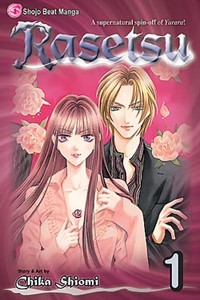Review
by Casey Brienza,Rasetsu
GN 1
| Synopsis: |  |
||
Rasetsu Hyuga bears a curse mark on her breast in the form of a rose—one that dooms her to a terrible fate should she be unable to meet the curse's stipulations. However, she will not take her misfortune lying down, and the teenaged sugar addict with the talent for banishing unquiet spirits has left school and taken full time employment with an exorcism agency. One of her assignments lands her in a library to purify a possessed book. The librarian's assistant who makes the request is Yako Hoshino, a young man with untapped defensive spiritual powers of his own. Somewhat against his will, Yako quickly becomes Rasetsu's assistant, and along with Kuryu, Aoi, and the Chief, he is exorcising ghosts with the best of them. Left undone, however, are the ghosts of Rasetsu's past… |
|||
| Review: | |||
Japanese manga and American comics have a lot more in common than fans of one or the other medium typically assume, and the cross-cultural influences have only been amplified in recent years—arguably to the benefit of both. However, there is one particular cultural borrowing from American comics that I for one wish that Japanese manga would ignore: the practice of naming series after the titular (superheroic) character. Ya know, like Green Lantern, Superman, or Wolverine. Yes, Japanese manga has done it too for a long time, dating back at least as far as so-called God of Manga Osamu Tezuka's Tetsuwan Atom (a.k.a. Astro Boy). But this practice hardly ever seems to bode well for the artistic quality of a manga. Relatively few manga characters are interesting and memorable enough to carry the weight of a series title on their (typically) ectomorphic shoulders…and Rasetsu of the mediocre disappointment Rasetsu, alas, is no exception. It is depressing to note that this titular problem is partially one created by Viz Media. The original title in Japanese is Rasetsu no Tsuki (“Rasetsu's Flower”), which, even on the basis of one volume, seems like a more apt title. Bear in mind that Rasetsu is a sequel of sorts to the prolific Chika Shiomi's earlier series Yurara, another banal supernatural schooldays story Viz Media also sort of renamed after its titular heroine, though you do not need to read one to read the other. Incidentally, the character of Yurara, lest you think that we are going in new visual directions here, bears remarkable physical similarity to Rasetsu. This fact is a minor plot point, but at least in the first volume of Rasetsu, it is a plot point that takes things precisely nowhere. The functionality right now appears simply to be to make the two series look similar on the bookstore shelves. How…exciting. Furthermore, the only major link between the two series is Yako, one of Yurara's love interests in Yurara and, well, most likely Rasetsu's primary love interest in Rasetsu. Unless, of course, the demon that put that pretty little rose mark in between her cleavage ever comes back. Lay odds the demon in question will look like a pretty boy. After all, it is that sort of series…the sort that revolves around the most tired of well-worn clichés. Even the premise—a for-profit ghost-busting agency—is as old as, well, GhostBusters, and the characters leave hardly any impression at all. Even Yurara is too one-dimensional to support a series named after her; even as a super-strong, independent-minded shoujo heroine, the main thing that you remember about her after the first two hundred-odd pages is that she's got major hypoglycemia and needs constant infusions of sugary confections in order to exorcise ghosts. Yes, this is supposed to be funny, but it is not particularly effective. None of the humor is, actually, and you will be hard-pressed to feel much of anything—whether fear (this is about ghosts, remember) or care (so much for the Shojo Beat slugline, “manga from the heart”). Even the fan service, personified primarily in the characters of the lecherous Chief and, to a lesser extent, the implacable Kuryu, who gets one über-cool moment late in volume one, feels limp-wristed and perfunctory. Yes indeed, Shiomi is just punching the clock here with Rasetsu. She is quite the prolific mangaka—many of her works, both major and minor, have been released in North America—and the overall quality of her output seems to suffer markedly as her output increases in speed and volume. The one thing this manga does have going for it is the quality of the artwork, which thankfully, does not resemble the plot in that it is neither rushed nor ill-considered. Shiomi draws like You Higuri and appeals to the same demographic with her handsome, asymmetrical layouts and slinky bodies. The two women share a penchant for bold, elegant lines and a judicious use of screen tone. Their characters designs also bear striking resemblance to each other, especially around the eyes. Though on the balance Shiomi is not quite as gifted as Higuri, the resemblance is certainly not to the former's detriment. All in all, this is definitely not a manga for the selective reader. There are better drawn titles out there, not to mention far superior storylines. Even if Rasetsu does improve in later installments, it will take a heck of a lot of “improvement” to justify the time required to exercise any interest in its brand of exorcism. |
|
The views and opinions expressed in this article are solely those of the author(s) and do not necessarily represent the views of Anime News Network, its employees, owners, or sponsors.
|
| Grade: | |||
Overall : C
Story : C-
Art : B
+ A strong heroine and attractively drawn artwork by a veteran shoujo manga professional. |
|||
| discuss this in the forum (5 posts) | | |||
| Production Info: | ||
|
Full encyclopedia details about Release information about |
||